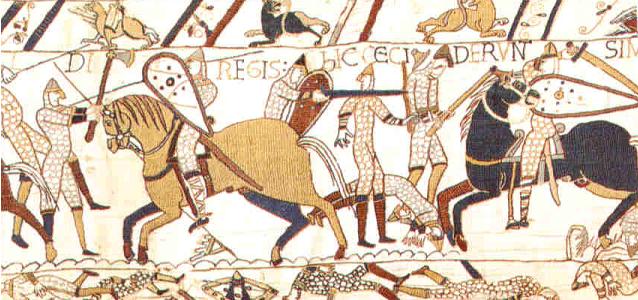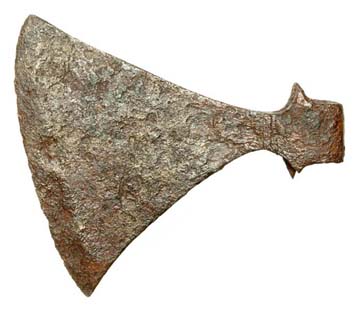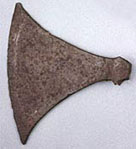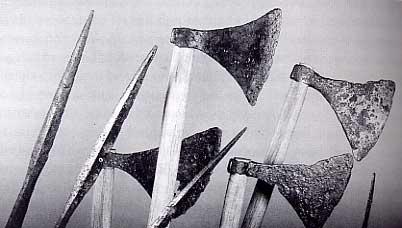I was wondering, which weapon could do more damage in a single stroke. I have heard that both of themn where able to cleave through plate and excetera, but which actually hit harder?
As i understood it, the longer pole axes have more leverage while the shorter axes like the dannish axe could have a heavier head. Which is more effective for brute force?
I guess it'll depend more on the user than the weapon itself. After all, there is no clear dividing line between the two. Some types, too, had additional protrusions like top spikes/spearheads and hooks on the back of the blade, both of which could be used to hurt the enemy in alternative ways.
Perhaps it would be more helpful if you can explain how you define "pole axe" and "two-handed axe." Neither is known to be a hard-and-fast definition in modern holpology circles, so different posters may have different answers for the question depending on how they define the two weapons.
I'm not so sure that either weapon was meant to cleave through plate armor. Cutting through poor-quality plate armor with insufficient padding might not have been an impossible feat, but good plate with enough padding would be very, very difficult to penetrate. I'd rather get a pick or a warhammer (a narrow-headed one, of course). And using either weapon with mere "brute force" would probably get the wielder dead in two seconds flat. Heavy though they were, they were meant to wielded with skill and not a little finesse.
Perhaps it would be more helpful if you can explain how you define "pole axe" and "two-handed axe." Neither is known to be a hard-and-fast definition in modern holpology circles, so different posters may have different answers for the question depending on how they define the two weapons.
I'm not so sure that either weapon was meant to cleave through plate armor. Cutting through poor-quality plate armor with insufficient padding might not have been an impossible feat, but good plate with enough padding would be very, very difficult to penetrate. I'd rather get a pick or a warhammer (a narrow-headed one, of course). And using either weapon with mere "brute force" would probably get the wielder dead in two seconds flat. Heavy though they were, they were meant to wielded with skill and not a little finesse.
I suspect the earlier two-handed axes usually had lighter heads. The two-handed axes A&A makes are both quite light. Waldman notes how light early halberd heads were.
As far as cleaving plate armor goes, I bet pollaxes and halberds would do a bit better, simply because they were designed during the era of plate. I don't think any axe could penetrate plate armor with ease. On the other hand, I don't think any helmet could fully protect the weilder against a full blow to the head.
As far as cleaving plate armor goes, I bet pollaxes and halberds would do a bit better, simply because they were designed during the era of plate. I don't think any axe could penetrate plate armor with ease. On the other hand, I don't think any helmet could fully protect the weilder against a full blow to the head.
| Benjamin H. Abbott wrote: |
|
As far as cleaving plate armor goes, I bet pollaxes and halberds would do a bit better, simply because they were designed during the era of plate. I don't think any axe could penetrate plate armor with ease. On the other hand, I don't think any helmet could fully protect the weilder against a full blow to the head. |
A fellow who studied the poleaxe for many years told me he felt that the axe head was only used for hooking techniques against armored foes, and the real striker was the spike or hammer hear that is invariably on the other side.
| George Hill wrote: | ||
A fellow who studied the poleaxe for many years told me he felt that the axe head was only used for hooking techniques against armoured foes, and the real striker was the spike or hammer hear that is invariably on the other side. |
The blade axe part may have made a grab at the poleaxe hazardous for someone wearing little armour on arms or hands ?
If aimed between plate the axe part might be able to make a cut but even without a cut the weight is the same if one hits with the axe blade or the hammer. The edge of the axe might get damaged more easily though hitting plate and might slide off while the hammer might transmit the energy of the blow.
Having an edge that can cut gives one options.
Last edited by Jean Thibodeau on Fri 26 Jan, 2007 4:57 pm; edited 1 time in total
| Quote: |
| A fellow who studied the poleaxe for many years told me he felt that the axe head was only used for hooking techniques against armored foes, and the real striker was the spike or hammer hear that is invariably on the other side. |
Well, many of the weapons we call pollaxes didn't even have axe heads at all. Fiore's pollaxe is a good example: hammer, beak, and a point on each end. No blade.
| Benjamin H. Abbott wrote: | ||
Well, many of the weapons we call pollaxes didn't even have axe heads at all. Fiore's pollaxe is a good example: hammer, beak, and a point on each end. No blade. |
Very true but some did have an axe head so I tried to think about what the advantages of having something sharp on the weapon.
Some would prefer the hammer on one side and a bec de corbin on the other: If anything can make a hole in plate I would think the bec the corbin would have the best chance.
If one was sure to be fighting someone in plate like in a duel then the versions with an axe blade would be less useful.
On a battlefield were one might be fighting against any level of armour the axe might be useful.
Oh, and the hooking techniques work well pulling or pushing the way most of the poleaxe head are shaped.
Getting back to the original question about axes and poleaxes I would think that two weapons of similar weight heads and about the same length hafts would be fairly close in effect when used both as an axe. Obviously the poleaxe with a hammer and a spike at both ends would have more versatility
| Marcus G wrote: |
| As i understood it, the longer pole axes have more leverage while the shorter axes like the Danish axe could have a heavier head. Which is more effective for brute force? |
Early medieval Danish Axes and later medieval pole axes were different weapons designed to defeat different armour. Both functioned fairly well in the job they were meant to do. Danish axes, as made famous by the Vikings and adopted by the Anglo-Saxons and even Anglo-Normans (King Stephen was said to be deadly with a two-handed axe), were designed against mail-armoured foes. Later medieval pole axes were designed to defeat foes in plate armour.
Danish axes could actually be fairly light. Their heads narrows significantly in the "middle", broadening again at a thickened edge. They could deliver fearsome blows; the axemen at Hastings gave the Normans some trouble, splitting the skulls of horses with great blows from their axes. I don't have numbers for actual Danish axes (which would be the heads only, I imagine) right now, but I've seen replicas weighing in at about 2 1/2 lbs. These were roughly between 44 and 56 inches in overall length. (One shown in the hand of guy of Ponthieu in the Bayeux Tapestry is a bit shorter, probably by a head, than his height.)
Later medieval pole axes were usually much heavier. They had an axe blade or hammer head backed by a hammer or spike, with another spike at the top. They also tended to have metal langets and rondels on the hafts. More metal means more mass. I do have a couple numbers for pole axes from the Royal Armouries Collection. In Treasures from the Tower of London by Norman and Wilson, a European pole axe with an axe blade backed by a "spiked" hammer, with a spike at top, weighs in at 6 lb 7 oz (2.92 kg), with an overall length of 70 in (177.8 cm). Another from the same source, this time a "Pole-hammer", a pole axe with a three-pronged hammer-head backed by a spike, with a spike at top, weighs in at 7 lb 11 oz (3.49 kg), with an overall length of 93.5 in (237.5 cm).
The later medieval pole axe undoubtedly varied in it's statistics, but it seems to have had a longer reach and greater weight than the earlier Danish axe. This would, in part, be due to the fact that it had to go up against more solid armour. Each weapon functioned well for what it had to deal with.
The weight and length of a pole axe may give you better leverage for a heavier blow. It may also be more versatile, with the hammer or spike opposite the blade or hammer, and the top spike. Plus, a spike at the butt could also be used as a weapon if needed. The earlier Danish axe was much simpler.
I hope this helped!
Maybe I can find some better numbers for the Danish axe later.
Stay safe!
Hi guys,
The Dane axe was mainly used to break up shield wall formations and not so much chainmail or plate armor. What's the best way to cut down a wall of wood(shields)? big freakin axes right! As for the pole axe it is a unique weapion that evolved with the armor for the most part. For example the late period pole axe used by the Swiss had certain task that it was used for. Swiss pike units usually had pole axes mixed in the units to counter swordsmen if they started to get through the pikes. Also the hook on the back of the swiss pole axe was used to assist swiss pikemen kill other pikemen. The way this was done is the Swiss halberdier would hook the pike tip and move it off to the side while the Swiss pikemen would then attack that individual.
Swiss halberd
http://www.diplomate.freeserve.co.uk/HALBERD2.JPG
The Dane axe was mainly used to break up shield wall formations and not so much chainmail or plate armor. What's the best way to cut down a wall of wood(shields)? big freakin axes right! As for the pole axe it is a unique weapion that evolved with the armor for the most part. For example the late period pole axe used by the Swiss had certain task that it was used for. Swiss pike units usually had pole axes mixed in the units to counter swordsmen if they started to get through the pikes. Also the hook on the back of the swiss pole axe was used to assist swiss pikemen kill other pikemen. The way this was done is the Swiss halberdier would hook the pike tip and move it off to the side while the Swiss pikemen would then attack that individual.
Swiss halberd
http://www.diplomate.freeserve.co.uk/HALBERD2.JPG
| D. Porter wrote: |
| Hi guys,
The Dane axe was mainly used to break up shield wall formations and not so much chainmail or plate armor. What's the best way to cut down a wall of wood(shields)? big freakin axes right! |
I don't think the shields were necessarily the target, I believe the men behind the shield were the intended targets. Also, some Anglo-Saxon warriors wielded these axes at Hastings. I don't think they were tagetting the Norman shields; they were targetting the Norman knights and their steeds. This is shown on the Bayeux Tapestry; one scene actually shows a Danish axe biting into the head of a horse! (see below)
As I mentioned earlier, King Stephen wielded an axe, probably along the lines of a Danish axe, at the battle of Lincoln in 1141. This is from Roger de Hoveden's chronicle, as presented in The Archaeology of Weapons by Ewart Oakeshott:
| Quote: |
|
Then was seen the might of the king, equal to a thunderbolt, slaying some with his immense battle axe and striking down others. Then arose the shouts afresh, all rushing against him and he against all. At length, through the number of his blows, the king's axe was broken asunder. Instantly drawing his sword with his right hand he marvellously waged the fight till the sword too was broken. On seeing this, William de Kahamnes, a most powerful knight, rushed upon the king and siezing him by the helmet cried with a loud voice, "Here! all of you, come here! I have taken the king!" |
A lone Norse warrior is said to have, for a time, single-handedly held up the Anglo-Saxon attack at the battle of Stamford Bridge (see my article about the battle here: http://www.myArmoury.com/feature_battle_stamford.html ). It is thought that this warrior was armed with a Danish axe, and felled many Anglo-Saxon warriors before being stabbed from beneath the bridge. King Harald Hardrada fell into such a battle fury that he rushed ahead of his men (thus ahead of the shield wall) and fought two-handed so that neither helmets nor mail could withstand his blows, again possibly with a Danish two-handed axe.
Shield were broken and eventually destroyed in battle, but that wasn't the intention of the attacker. The intention was to kill their foe, pure and simple. The two-handed Danish axe may actually have been developed as a response to the increased use of mail in the later Viking age, at least according to Mark Harrison (Viking Warrior, aka Viking Hersir 793-1066 AD).
Note the horse with an axe in its skull in this portion of the Bayeux Tapestry:

Bayeux Tapestry - Anglo-Saxon axemen against Norman horsemen.
| Quote: |
| If one was sure to be fighting someone in plate like in a duel then the versions with an axe blade would be less useful. |
I suspect polearm blades could sometimes penetrate armor. Charles the Bold supposedly had his helmet split by a halberd. Waldman seems to think halberds could do this. Di Grassi wrote about partisans being made to break the mail and divide the iron.
There are also various examples axes splitting helms in both artwork and writing, though most of these are somewhat dubious.
Hello again!
I thought I would show some photos of surviving Viking axes, to show how light and thin the axe head could be. Note the thickened edges on most of the axe heads.
Compare the Viking axes below to the pole axes in this spotlight article, which includes some weights:
http://www.myArmoury.com/feature_spot_poleaxe.html
Here's the information for the first image, from the London Museum:
.
 Attachment: 39.87 KB
Attachment: 39.87 KB

Viking Axe from the London Museum.
 Attachment: 25.56 KB
Attachment: 25.56 KB

Viking axe.
 Attachment: 12.15 KB
Attachment: 12.15 KB

Viking axe.
 Attachment: 19.23 KB
Attachment: 19.23 KB

Viking axes and spears.
I thought I would show some photos of surviving Viking axes, to show how light and thin the axe head could be. Note the thickened edges on most of the axe heads.
Compare the Viking axes below to the pole axes in this spotlight article, which includes some weights:
http://www.myArmoury.com/feature_spot_poleaxe.html
Here's the information for the first image, from the London Museum:
| Quote: |
|
Date: Late Saxon Accession number: A15675 Place of collection: Runnymede, Surrey [River Thames] Material: iron Measurements: whole: 206 x 192 mm; Centre: 5 mm This iron battle axe was found in the Thames at Runnymede in Surrey. The blade is decorated with small dots and its edge has been sharpened. The weapon may have belonged to a Viking invader on board the Danish war fleets which entered the London area in the early 11th century. Raids led to the Danish King Cnut becoming King of England between 1016 and 1035 |

Viking Axe from the London Museum.

Viking axe.

Viking axe.

Viking axes and spears.
| Jean Thibodeau wrote: |
| Very true but some did have an axe head so I tried to think about what the advantages of having something sharp on the weapon.
Some would prefer the hammer on one side and a bec de corbin on the other: If anything can make a hole in plate I would think the bec the corbin would have the best chance. |
All Fechtbücher that show pollaxe combat except Codex 11093 show or describe pollaxes that consist of a hammer head ("mail") backed with a bec de faucon, and not a single one of them (not even 11093) show or describe the bec being used to strike at all. The bec is used exclusively to hook things. I think I've studied all of the extant fighting manuals from prior to 1500 that teach pollaxe and I have never--not once--seen anything that tells you to try to break plate with any part of the pollaxe. Fiore claims it can be done with the top spike, but never shows any technique (in the pitifully few he shows) that is intended to do so.
When you look at extant pollaxes with blades you get the impression the blade was never super sharp--not even hatchet sharp, if you see what I mean (not that the few I've seen should be taken as a fully-representative sample). But when you look at them you also notice that almost without exception they have spikes on top and on the bottom of the blade--perfect for hooking. In fact, with my reproduction pollaxe we've found that these hooks on the blade are actually a little more effective at hooking than a bec, and rather horrifying when you do so because the hook is *sharp* and catches cruelly in the flesh when you do so (e.g., when hooking behind the poleyn as in Le Jeu de La Hache paragraph 22)--not that we've ever done it full speed with the steel, but accidents do happen.
Finally, when you strike something rigid (e.g., plate) with the blade of a bladed pollaxe you'll find that there's a degree of "wobble" that's hard to overcome whereas a strike with the mail (the hammer head) actually seems to "stick" to the plate becuse of the teeth carved into the face. This makes for a much better transmitter of force. You don't try to make a hole in plate ebcause it's just not likely enough to be worth betting on in a serious fight.
So it's possible some bladed axes were sharp for fighting against largely unarmored troops, but for anyone in armor the mail was the real weapon and the blade was a hook. You hit to the head, hands and feet with the mail, and for evrything else you thrust with the dague (top spike) or queue (butt spike) into the gaps between plates. You were never foolish enough to strike the chest or shoulders or even thighs when they were covered in plate because nothing's going to do much there except in friendly deeds of arms where you did it to prove how macho you are in a sort of WWF way; or, to take Shakespear out of context, "full of sound and fury, signifying nothing".
Oh, and to answer the original poster: I think the "felt force", that is the actual impact the recipient feels, would be much higher from a pollaxe (striking with the mail) than from a "battle axe" because of the blade wobble effect I wrote about above. A halberd would probably hit much the same as a pollaxe.
If you go to my Schule's web page you can see some representative pollaxe techniques here: http://www.schlachtschule.org/pollaxe/inst9.html
Regards,
Hugh

Note the very sharp spikes on either end of this blade.
Page 1 of 1
You cannot post new topics in this forumYou cannot reply to topics in this forum
You cannot edit your posts in this forum
You cannot delete your posts in this forum
You cannot vote in polls in this forum
You cannot attach files in this forum
You can download files in this forum
All contents © Copyright 2003-2006 myArmoury.com — All rights reserved
Discussion forums powered by phpBB © The phpBB Group
Switch to the Full-featured Version of the forum
Discussion forums powered by phpBB © The phpBB Group
Switch to the Full-featured Version of the forum